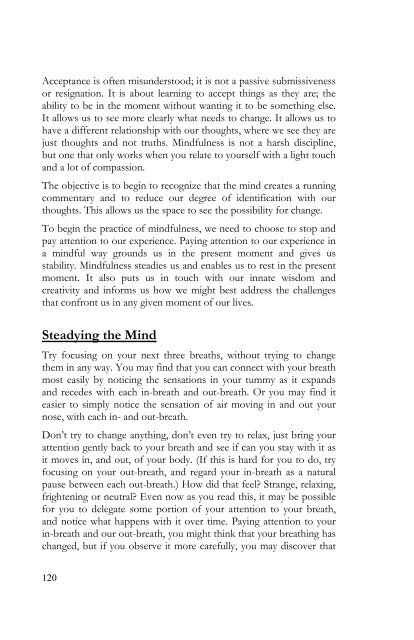Introduction to Mindfulness - Dean Amory
Art and Benefits of Mindfulness Meditation
Art and Benefits of Mindfulness Meditation
Create successful ePaper yourself
Turn your PDF publications into a flip-book with our unique Google optimized e-Paper software.
Acceptance is often misunders<strong>to</strong>od; it is not a passive submissiveness<br />
or resignation. It is about learning <strong>to</strong> accept things as they are; the<br />
ability <strong>to</strong> be in the moment without wanting it <strong>to</strong> be something else.<br />
It allows us <strong>to</strong> see more clearly what needs <strong>to</strong> change. It allows us <strong>to</strong><br />
have a different relationship with our thoughts, where we see they are<br />
just thoughts and not truths. <strong>Mindfulness</strong> is not a harsh discipline,<br />
but one that only works when you relate <strong>to</strong> yourself with a light <strong>to</strong>uch<br />
and a lot of compassion.<br />
The objective is <strong>to</strong> begin <strong>to</strong> recognize that the mind creates a running<br />
commentary and <strong>to</strong> reduce our degree of identification with our<br />
thoughts. This allows us the space <strong>to</strong> see the possibility for change.<br />
To begin the practice of mindfulness, we need <strong>to</strong> choose <strong>to</strong> s<strong>to</strong>p and<br />
pay attention <strong>to</strong> our experience. Paying attention <strong>to</strong> our experience in<br />
a mindful way grounds us in the present moment and gives us<br />
stability. <strong>Mindfulness</strong> steadies us and enables us <strong>to</strong> rest in the present<br />
moment. It also puts us in <strong>to</strong>uch with our innate wisdom and<br />
creativity and informs us how we might best address the challenges<br />
that confront us in any given moment of our lives.<br />
Steadying the Mind<br />
Try focusing on your next three breaths, without trying <strong>to</strong> change<br />
them in any way. You may find that you can connect with your breath<br />
most easily by noticing the sensations in your tummy as it expands<br />
and recedes with each in-breath and out-breath. Or you may find it<br />
easier <strong>to</strong> simply notice the sensation of air moving in and out your<br />
nose, with each in- and out-breath.<br />
Don’t try <strong>to</strong> change anything, don’t even try <strong>to</strong> relax, just bring your<br />
attention gently back <strong>to</strong> your breath and see if can you stay with it as<br />
it moves in, and out, of your body. (If this is hard for you <strong>to</strong> do, try<br />
focusing on your out-breath, and regard your in-breath as a natural<br />
pause between each out-breath.) How did that feel? Strange, relaxing,<br />
frightening or neutral? Even now as you read this, it may be possible<br />
for you <strong>to</strong> delegate some portion of your attention <strong>to</strong> your breath,<br />
and notice what happens with it over time. Paying attention <strong>to</strong> your<br />
in-breath and our out-breath, you might think that your breathing has<br />
changed, but if you observe it more carefully, you may discover that<br />
120

















